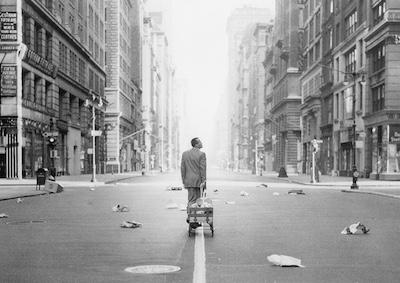Admission is free. No advance reservations. Your seat will be assigned to you when you pick up your ticket at the box office. Seats are assigned on a first come, first served basis. The box office opens one hour before the event.
A post-apocalyptic Earth is the ideal setting for romantic yearning and rivalry. The World, the Flesh and the Devil and The Quiet Earth each feature a male protagonist (Harry Belafonte, Bruno Lawrence) finding himself in familiar surroundings, but missing a population after living through an environmental catastrophe. Adjusting to the loneliness of their last-man-standing status, these heroes are elated to encounter the second-last person, a beautiful woman. In both films, the novelty of being the only couple creates a euphoria as the pair romp around their respective ghost towns enjoying free rein in deserted department stores and cruising empty streets in abandoned vehicles. Although traffic laws cease to exist, social hierarchies are inflamed when a third survivor appears and a love triangle forms.
Notes by Maya Montañez Smukler
The World, the Flesh and the Devil
U.S., 1959
The World, the Flesh and the Devil was the first feature released by Harry Belafonte’s independent production company, HarBel Productions. A Cold War social drama, the film uses the science fiction genre to present an allegory about racism in contemporary America during the civil rights era. Belafonte, successful singer, actor and now producer, was a leading figure in the movement and understood that his shared identity as an activist and celebrity was powerful. Writing in his autobiography, My Song: A Memoir, the leading man hoped that in this film, where he played opposite white actress Inger Stevens, “I would have another chance to contribute to the national conversation on race.” However, Hollywood in the late 1950s proved to be more radioactive than a post-apocalyptic Earth, and the producers revised the script. And while Belafonte and his co-stars saw an opportunity to breach the taboo of interracial love on screen, their characters struggle to shed old-world prejudices in the new world order.
35mm, color, 95 min. Director/Screenwriter: Ranald MacDougall. With: Harry Belafonte, Inger Stevens, Mel Ferrer.
35mm print courtesy of the Paul Rayton Collection at the UCLA Film & Television Archive.
Watch a trailer:
The Quiet Earth
New Zealand, 1985
The Quiet Earth pays tribute to the Harry Belafonte film, The World, the Flesh and the Devil, 25 years later by reshuffling the power dynamic across racial and gender lines. Bruno Lawrence and Alison Routledge, the initial survivors, are white and soon to be joined by Peter Smith, who is Māori. As the two men partake in the obligatory dance of male rivals vying for a single woman’s affection, she carefully considers her choices, often mediating her suitors’ delicate male egos: desire and competition are heightened on a lonely planet. The legacy of the Māoris’ oppression under white colonialism in New Zealand shares the toxicity of the scientific experiment that has eliminated humankind. The sexual anxiety sparked by interracial relationships promises even more planetary shifts.
DCP, color, 91 min. Director: Geoff Murphy. Screenwriters: Bill Baer, Bruno Lawrence, Sam Pillsbury. With: Bruno Lawrence, Alison Routledge, Peter Smith.
Watch a trailer:






 Mobile Navigation
Mobile Navigation

